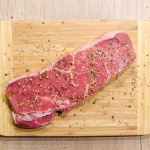top of mind news
- How to Increase Restaurant Foot Traffic During Slow Summer Months
- MRM EXCLUSIVE: Attracting Restaurant Employees in the Gig Economy
- Tariffs could broadly impact restaurant industry
- 5 High Impact Summer Promotions
- Will the Restaurant Industry’s Traffic Bubble Burst?
the farm
Poultry
 For the holiday week ending June 1st, ready-to-cook (RTC) chicken production declined from the previous week, but also from a year ago. Lighter bird weights continue to temper broiler output gains. Still, bigger production schedules are expected to occur heading into the summer, but margin pressures have materialized due to rising feed costs. The chicken wing markets remain elevated for this time of year and have resisted the seasonal downside pressure that usually occurs from March into the late summer. Still, we continue to anticipate lower wing pricing ahead. The boneless skinless chicken breast markets are fading, and more downside potential is likely.
For the holiday week ending June 1st, ready-to-cook (RTC) chicken production declined from the previous week, but also from a year ago. Lighter bird weights continue to temper broiler output gains. Still, bigger production schedules are expected to occur heading into the summer, but margin pressures have materialized due to rising feed costs. The chicken wing markets remain elevated for this time of year and have resisted the seasonal downside pressure that usually occurs from March into the late summer. Still, we continue to anticipate lower wing pricing ahead. The boneless skinless chicken breast markets are fading, and more downside potential is likely.
Beef
 Beef production picked up last week following the prior holiday shortened week, up more than 13% but was only slightly below last year. Retail beef features were relatively lackluster throughout late-May, but wholesale buying activity has increased due in part to attractive cutout prices. The Choice cutout is down more than 2% from last year and further downside potential is expected well into the late summer. Lighter cattle carcass weights continue to support the beef 50s, with prices firming into the mid-$0.90s. Yet, mostly sideways to lower pricing is likely for beef 50s in the summer when beef interest wanes.
Beef production picked up last week following the prior holiday shortened week, up more than 13% but was only slightly below last year. Retail beef features were relatively lackluster throughout late-May, but wholesale buying activity has increased due in part to attractive cutout prices. The Choice cutout is down more than 2% from last year and further downside potential is expected well into the late summer. Lighter cattle carcass weights continue to support the beef 50s, with prices firming into the mid-$0.90s. Yet, mostly sideways to lower pricing is likely for beef 50s in the summer when beef interest wanes.
Pork
 While pork production was up last week, expectedly, from the Memorial Day shortened week prior, output jumped nearly 9% from a year ago, notching the largest pork production week for June in history. Amid escalating pork output, the USDA pork cutout has been mostly steady in the mid-$0.80s, with only the hams making appreciable gains recently. Bellies continue to move mostly sideways to lower, struggling to gain much traction despite nearing the peak demand timeframe. Current pork belly prices are engaging when looking at history.
While pork production was up last week, expectedly, from the Memorial Day shortened week prior, output jumped nearly 9% from a year ago, notching the largest pork production week for June in history. Amid escalating pork output, the USDA pork cutout has been mostly steady in the mid-$0.80s, with only the hams making appreciable gains recently. Bellies continue to move mostly sideways to lower, struggling to gain much traction despite nearing the peak demand timeframe. Current pork belly prices are engaging when looking at history.
The Sea
Seafood
 The salmon market continues to track above year ago levels. But this factor and an inflated value of the U.S. dollar are encouraging imports. During April, the U.S. brought in 18% more salmon than the prior year. Atlantic salmon filet imports were higher by 12% (yoy). Fairly solid imports are anticipated to continue which should limit the upside risk in prices.
The salmon market continues to track above year ago levels. But this factor and an inflated value of the U.S. dollar are encouraging imports. During April, the U.S. brought in 18% more salmon than the prior year. Atlantic salmon filet imports were higher by 12% (yoy). Fairly solid imports are anticipated to continue which should limit the upside risk in prices.
The Garden
Produce
 The lettuce markets have found support during the last week due to a tempering in supplies. Iceberg lettuce shipments last week were 9% less than the same week a year ago. Romaine shipments were 4% better than 2018. History suggests that further iceberg lettuce price increases could occur in the near term. The five-year average trend for the iceberg market during the next two weeks is a rise of 5.7%. The California avocado harvest remains subpar with year-to-date shipments tracking well below 2018 levels. Elevated avocado prices could persist.
The lettuce markets have found support during the last week due to a tempering in supplies. Iceberg lettuce shipments last week were 9% less than the same week a year ago. Romaine shipments were 4% better than 2018. History suggests that further iceberg lettuce price increases could occur in the near term. The five-year average trend for the iceberg market during the next two weeks is a rise of 5.7%. The California avocado harvest remains subpar with year-to-date shipments tracking well below 2018 levels. Elevated avocado prices could persist.
The kitchen sink
Dairy
The cheese block market this week is the highest in 17 months. Cheese demand is solid. April U.S. cheese exports were down 1.3% from the prior year but the third best for the month on record. Cheese prices usually soften in late-June but rise thereafter. Since 2014, the average move for the cheese block market from July through late-August was up 11.5%. Spot butter prices are near a 12-month high. April butter exports were down 71% from last year. Still, U.S. butter demand is strong, and production has been only modest. The butter markets normally remain firm during the summer.
Grains
 The weather has modestly improved as of late, and notable corn and soybean planting occurred last week. Still, nearly 50 million acres of corn and soybeans are left to plant which is a record for this time of the year. Some corn acreage and yield losses are anticipated with upcoming USDA reports which could keep the markets erratic.
The weather has modestly improved as of late, and notable corn and soybean planting occurred last week. Still, nearly 50 million acres of corn and soybeans are left to plant which is a record for this time of the year. Some corn acreage and yield losses are anticipated with upcoming USDA reports which could keep the markets erratic.
Oil
 Nearby diesel fuel (ultra-low) futures are up slightly from last week when they hit the lowest level since January. The EIA’s most recent weekly national average retail diesel fuel price was $3.105/gal, the cheapest in eight weeks. Diesel fuel prices usually establish a peak for the year during June.
Nearby diesel fuel (ultra-low) futures are up slightly from last week when they hit the lowest level since January. The EIA’s most recent weekly national average retail diesel fuel price was $3.105/gal, the cheapest in eight weeks. Diesel fuel prices usually establish a peak for the year during June.






